
Flowering stand of San Pedro cacti (Trichocereus pachanoi)
To me the main draw of the San Pedro cactus (Trichocereus pachanoi (syn. Echinopsis pachanoi)), a fast-growing columnar cactus native to the Andes Mountains of Ecuador and Peru, has always been that it is unsurpassed as a grafting stock. In my opinion it is the perfect rootstock for grafted peyote and similar cacti, as it ensures fast growth and is long-lived.
That being said a towering stand of San Pedro cacti is spectacular in its own right, and the large, beautiful, fragrant flowers are nothing less than awesome!

San Pedro cactus flower bud
I took these pictures last summer but will not disclose the exact location. After peyote (Lophophora williamsii) the San Pedro cactus is one of the most mescaline rich species of cacti and is widely sought after for recreational use - I’m sure the grower of these plants will be quite angry if they are maimed and disfigured by “I, me, mine” types looking for a quick trip. If you are so inclined, grow your own plants.

Spent San Pedro flower
As I said, San Pedro flowers are nothing less than awesome :-)

San Pedro cactus (Trichocereus pachanoi) flower close-up
Tuesday, February 05, 2013
Flowering San Pedro cactus (Trichocereus pachanoi)
Sunday, January 27, 2013
Snow covered cacti on the balcony

Escobaria vivipara with a light snow cover
I’m fascinated by the ability of certain cacti species to survive even quite extreme freezing conditions. A fascination that is probably rooted in my childhood belief that all cacti were heat craving desert dwellers that would succumb to subfreezing temperatures - great was my surprise the first time I saw pictures of a cactus covered in snow.

Echinocereus triglochidiatus var. mojavensis sprinkled with snow
I live in a condominium and the only possibility for pursuing my interest in growing frost tolerant cacti outdoors - apart from the bed of winter-hardy cacti at my summerhouse - is to grow cacti in flower boxes on the balcony.
For several years I have successfully grown Echinocereus triglochidiatus (claret cup hedgehog cactus) outdoors (year-round) at my summerhouse in the northwestern part of Denmark - inspired by this I acquired a few E. triglochidiatus var. mojavensis (DJF1273; North of Inyo County, California) plants for my flower boxes a couple of years ago and they are also doing great.

Escobaria missouriensis in the snow
The well-being of the Escobaria species are of greater concern to me. The Botanical Garden of Copenhagen attempted growing Escobaria in their outdoor cactus bed but they all perished. My plants still seem to be weathering it out here in Copenhagen but I’m concerned that the continuous frost-thaw cycles will expose the plants to killing moisture.
Denmark has been frost-bound for several weeks now with the plants seeing temperatures as low as -10 C (14 F) (this is nothing for Escobaria vivipara which is known to have survived extreme temperatures as low as -35 degrees C) but the frost now loosens its grip again and it has started to rain, soaking the flower boxes that are still frozen solid. I hope that the light shelter provided by the balcony on the floor above will keep the plants from getting too wet - if not, I reckon the rot will soon show in the coming period of relatively warm and humid weather.
The beehive cactus species I’m growing in flower boxes on the balcony are Escobaria vivipara (Alberta, Canada) and Escobaria missouriensis (Mesa County, Colorado; SB204)

Flower box with Escobaria and Echinocereus cacti in the snow
This coming season I plan to grow peyote cactus in outdoor window boxes as well - but I don’t expect peyote to cope well with the Danish winter so the plants will need to be wintered in the attic.
Below are a few pictures of the balcony grown Escobaria plants during summer - what a happy flowering bunch :-)

Flowering Escobaria vivipara (Alberta, Canada)
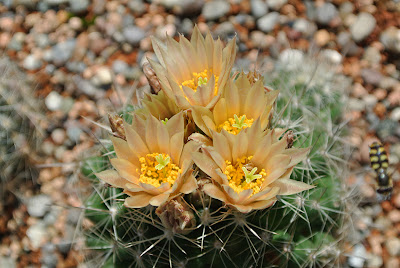
Flowering Escobaria missouriensis (Mesa County, Colorado; SB204)
In relation to the two above images, the previous post featured a high-speed video showing the flower fly hovering above the Escobaria vivipara cactus.
Tuesday, January 08, 2013
Time-lapse video of a flowering Ariocarpus kotschoubeyanus var. macdowellii cactus
Flowering Ariocarpus kotschoubeyanus var. macdowellii (SB 100; El Pilar, Coahuila) - please note that the time-lapse video is generated with a fairly high frame rate meaning that you can slow down the video to 0.5x its speed (or even 0.25x) with good results - the playback speed is controlled via the settings for the YouTube video.
As mentioned in the previous post I broke the shutter of my old faithful Nikon D70 SLR camera while capturing photos for a time-lapse video of a flowering peyote. A time-lapse video of just a few seconds duration requires hundreds of photos and thus imposes a considerable wear on SLR cameras with mechanical shutters. Consequently I have avoided using my new SLR for time-lapse shooting and instead experimented with alternative solutions. One of these being iTimeLapse Pro for the iPhone - an app that allows you to control basic settings like the capture interval, when to stop and start capturing images, and the capture resolution.
The app was used for shooting the images for this video and as such functions just fine, but I still need to work on enhancing the steadiness of the phone (it slid slightly on its stand during the capture sequence), and on tuning the focus (which is slightly behind the center of the flower, making the flower itself look blurry). Also the images are taken in natural light that changes continuously giving the video a flickering appearance - on the other hand the change in light is also responsible for the flower closing again, adding to the video.
I also shot photo sets for a flowering peyote ( Lophophora williamsii var. echinata) and a Gymnocalycium calochlorum and will generate and upload time-lapse videos for these as time permits.
For the technically inclined it must be mentioned that the video was generated using FFmpeg, a free set of tools to record, convert, stream and play multimedia content. FFmpeg can be downloaded here. The photos used in the video were shot one every 15 seconds and is played back at a rate of 25 images per second. The time-lapse video comprises 1001 still images.
If the video doesn't embed properly you can view it in a separate window by clicking the picture below.

Monday, April 11, 2011
Peyote flowers - fisheye/tilt-shift photography
I just got me a Lensbaby Composer lens and of course had to experiment taking pictures of some of my flowering peyote plants. Even though the subject line mentions “tilt-shift” the Composer technically only qualifies for the “tilt” part (a rotation of the lens plane relative to the image plane) and actually doesn’t “shift” (i.e. doesn’t allow for movement of the lens parallel to the image plane) but I’ll stick to the “tilt-shift” label as it is often used to specifically refer to the use of tilt for selective focus as illustrated in the photo above.
Flowering Lophophora jourdaniana - fisheye/tilt-shift
Adding the Lensbaby fisheye optic to the Composer allows for an even more distorted and warped view on reality.
Warped peyote flower - fisheye/tilt-shift
Tuesday, June 08, 2010
Flowering Normanbokea valdeziana (Turbinicarpus valdezianus)
My coldhouse grown Normanbokea valdeziana plants (SB 1468; Ramos Arizpe, Coahuila, Mexico) have flowered before but I’ve never had the chance to actually experience the bloom until a few weeks ago.

Flowering Normanbokea valdeziana
The petals are a pinkish white with a darker magenta midstripe, giving me strange associations to candy canes ;-) The filament and stigma are pure white while the anthers are a bright yellow. The flower is huge compared to the body of the plant, completely hiding it when seen from above.

Normanbokea valdeziana flower hiding plant
Normanbokea valdeziana is slow growing and its tiny feathery spines almost completely obscure the body of the plant – it is said to sometimes form clusters but all of my plants are solitary.

Normanbokea valdeziana flower
This species is capable of surviving hard, extended frost – all of my plants even made it through last winter’s extremely cold conditions without any damage.
Sukkulentarium Muthandi recently featured five flowering Normanbokea valdeziana plants, all displaying fairly different flowers.
Wednesday, April 28, 2010
The power of grafting – 6th anniversary
A week ago my grafted Lophophora williamsii (SB 854; Starr Co, Texas) celebrated its 6th anniversary sitting on top a sturdy Trichocereus pachanoi stock. The plant was grafted as a tiny seedling and in 6 years the main head has grown to a width of approximately 8 cm (~3.2'') – the 3 largest offshoots are 6 cm (~2.4'') wide each. The main head seems to have stabilized at 8 ribs while the largest pups are in transition from 5 to 8 ribs.

Lophophora williamsii graft, top view
The last couple of weeks the plant has “popped out” fruits resulting from last years late flowers. This season’s first flower appeared a couple of days ago and was promptly (self-)pollinated – according to previous experience this should result in another fruit in 7-8 weeks time.

Grafted Lophophora williamsii, first flower of the season
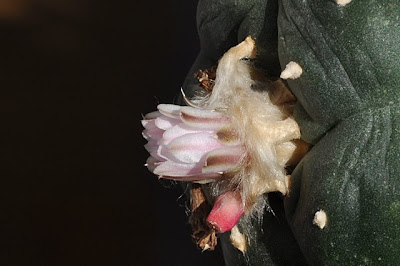
Lophophora williamsii flower and fruit
I’ve already harvested more than 120 seeds from this plant alone this season. As this variety of Lophophora williamsii is not particularly frost hardy I’m not sure if I’ll start all these seeds as the seedlings will have to go to my coldhouse – maybe I should set up a “swap shop” instead ;-)

Lophophora williamsii fruits
I’m wondering for how long the Trichocereus pachanoi stock will be able to support the rather large Lophophora williamsii scion. This is my oldest graft so I have no experience to rely on regarding the actual longevity of Trichocereus stock plants; I guess time will tell.

Lophophora williamsii grafted on Trichocereus pachanoi stock
For comparison you can check the posts on the same graft as one, two, three, four, and five years old.
Saturday, April 24, 2010
Flowering Lophophora koehresii, spring 2010
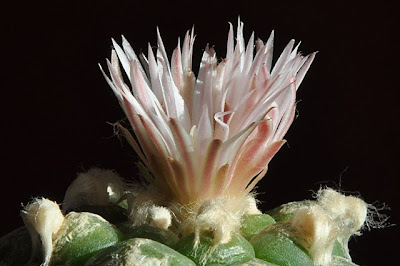
Flowering Lophophora koehresii
My grafted Lophophora koehresii (RS 1182; El Sabino, San Luis Potosí) just flowered for the first time this growing season.
The light pink flower with unusually thin petals having a darker midstripe is true to the species. What appears to be a “double-flowered” variety with extra petals in the picture above is in reality just three flowers unfolding at the same time.

Lophophora koehresii flowers, top view
The Lophophora koehresii scion was badly disfigured by spider mites but managed to outgrow some of the scarring after I started showering my plants regularly and treating them with neem oil – a treatment I intend to continue this year as it seems to be an effective means of controlling the spider mites (and with a bit of luck the plant will outgrow its defacing completely in a couple of years).

Lophophora koehresii disfigured by spider mites
The Trichocereus pachanoi stock plant hosts two different Lophophora koehresii clones (RS 1182; El Sabino, San Luis Potosí), both started from seed March 3, 2007. The first scion was grafted June 7, 2007 and when the Trichocereus pachanoi stock plant grew an offset I grafted another seedling on it May 5, 2008 (the second scion is visible in the foreground of the above picture). I intend to get seeds off this self-sterile species and just need to wait for the second Lophophora koehresii clone to flower before this “all inclusive” graft starts to produce seed ;-)
Sunday, April 04, 2010
Flowering Lophophora fricii
I don’t have many mature Lophophora fricii plants in my collection (but have quite a few seedling plants “in the works”). Last year one of my few adult L. fricii plants put out several of its characteristic large, striking pink flowers, reminding me why I need to grow more plants of this species ;-)

Lophophora fricii flower
This particular Lophophora fricii plant was started from seed in the spring of 2002 and is, after a slow start (and some neglect), developing into a nice mature specimen.

Flowering Lophophora fricii
I don’t have any locality information for this plant; it was started from seed before I went nerdy and started bothering about “details” like that ;-)
Sunday, March 21, 2010
Acharagma roseana – flowers and fruits
To be honest, Acharagma roseana plants are not particularly ingratiating – the flowers are not breathtaking nor is the spination stunning. To me, the attraction of A. roseana lies in its close relationship with Lophophora and Obregonia, making it an obvious candidate for hybridization experiments.
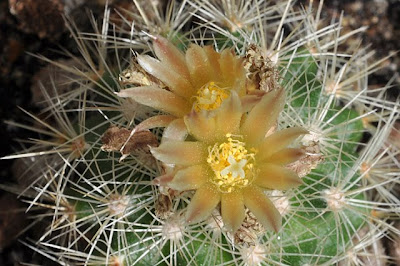
Acharagma roseana flower with pale yellowish tepals with brownish pink midveins
Gene sequence studies by Butterworth et al. (2002) suggest that Acharagma belongs in a well-supported taxonomic clade with Lophophora and Obregonia. They sum up their results as follows:
LOPHOPHORA CLADE. Although there is strong support for this clade (87% bootstrap, 5 decay steps), few morphological features unite this clade. All members have napiform or carrotlike tap-root systems, although these features are also found in other members of the tribe.
The two species of Acharagma have been a source of taxonomic confusion. […] The rpl16 intron data suggest the removal of these two species from Escobaria, placing them in a well-supported (bootstrap 87%, decay 5) clade containing Obregonia and Lophophora, the latter shown to be polyphyletic based on this topology.
(the closing remark on Lophophora being polyphyletic is an interesting statement in its own right, but that’s a whole other story)

Acharagma roseana flower with pink tepals with darker red-tinged midstripe
In The New Cactus Lexicon, Hunt describes this species as Acharagma roseanum - I’m not sufficiently well-versed in the Latin language to say which form of the name is correct, but according to this site on botanical Latin the specific epithet must match the genus name in gender. As Acharagma is from the Greek a, without, charagma, groove (the gender of which, according to Hunt, is neuter) this would warrant the “-um” ending. I’m a firm believer in applied laziness so I’ll stick to the (apparently erroneous) “-a” ending for a wee bit longer and avoid having to re-label my plants ;-) Hunt accepts two subspecies: ssp. roseanum and ssp. galeanense, the latter having more spines and slightly larger, cylindrical bodies, compared to the egg-shaped body of the typical form.

Comparison of the two different color forms of Acharagma roseana flowers
The Acharagma roseana plants featured in this post were started from seed in 2005 and flowered freely last summer. As mentioned I would like to use these plants for hybridization experiments with Lophophora but I still need to come up with a good protocol for avoiding self-pollination. The locality information for these specific plants is: LX 578; Ramon Arizpe, Coahuila - “Ramon” should probably read “Ramos” but I'll stick to the information from the vendor’s seed list.

Acharagma roseana with fruits
Like most other parts of Acharagma roseana the fruits are not showy either. They are an inconspicuous yellowish green color, but have a surprising, not unpleasant, tart taste reminiscent of gooseberries.
The plants grow in my unheated greenhouse and I hope they survive the month long cold snap that is just now loosening its grip of Denmark.
Monday, March 15, 2010
Echinocereus engelmannii v. armatus - flower and fruit
My Echinocereus engelmannii v. armatus (Joshua Tree National Park, California) flowered for the first time in the late spring of ‘09.
Echinocereus engelmannii v. armatus flower, close-up
The flower was beautiful with bright yellow anthers, a mesmerizing green stigma, and petals ranging from intensive pink to almost crimson at the center of the flower.
Flowering Echinocereus engelmannii v. armatus
The plant easily lives up to its varietal name - even the flower stalk is heavily armed with spines, protecting the ovary and the coming fruit.
Echinocereus engelmannii v. armatus flower armed with spines
I hand-pollinated the flower and two months later the plant bore fruit. This is the only mature Echinocereus engelmannii v. armatus in my collection and no other Echinocereus plants flowered at the time so my E. engelmannii v. armatus seems to be self-fertile. Time will tell if the seeds are viable.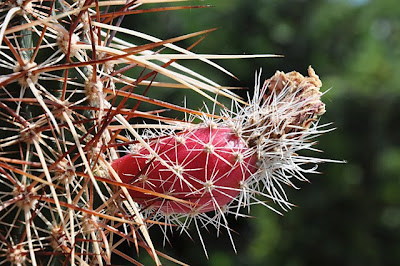
Echinocereus engelmannii v. armatus with fruit
Echinocereus engelmannii v. armatus with fruit, top view
Sunday, February 21, 2010
Flowering Mammillaria meiacantha
I've had a few Mammillaria meiacantha plants (SB 249; Bernalillo County, New Mexico) growing in my cold house for the last couple of years. The plants thrive and last spring they embarked on a flowering spree.
Mammillaria meiacantha flower
One of the traits Steve Brack mentions for these plants in his seed catalogue are their huge red fruits, so I hope I succeeded in pollinating the flowers and will see some fruits soon.
Flowering Mammillaria meiacantha
I bought these plants for my unheated greenhouse because of their extreme cold tolerance. Steve Brack classifies Mammillaria meiacantha as being safe easily to -10F (-23C). So these plants, if any, ought to be able to survive the cold snap that has engulfed Denmark in snow and almost constant (severe) frost for more than two months now.
Mammillaria meiacantha is also known as Mammillaria heyderi v. meiacantha.
Monday, February 15, 2010
Flowering Mammillaria grahamii
In the late spring of '09 I bought a handful of Mammillaria grahamii (SB 507; Dona Ana County, New Mexico) from Kakteen-Haage. A few months after receiving the plants they flowered vigorously.
Mammillaria grahamii flower
The all-pink petals and filaments are beautifully contrasted by the bright yellow anthers and the dusty chartreuse stigma. I cross-pollinated several of the flowers and hope for seeds next year.
Flowering Mammillaria grahamii
I bought the plants for my cold house as Mammillaria grahamii is said to be relatively cold hardy. If they survive the current cold snap I guess they can survive anything (in relation to Danish winters, that is ;-) The current freezing conditions have lasted since before Christmas with outdoor temperatures as low as -15 C (5 F) so I hope the plants are not frozen solid.
Hooked Mammillaria grahamii spine
Seeing the Mammillaria grahamii spines up close it is easy to understand why it is also called fish-hook cactus ;-)
Tuesday, December 15, 2009
Flowering Ariocarpus kotschoubeyanus var. macdowellii
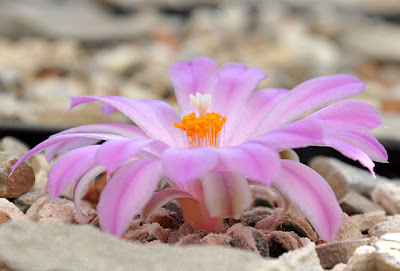
Flowering Ariocarpus kotschoubeyanus var. macdowellii
As mentioned in an earlier post I'm fairly inexperienced when it comes to growing Ariocarpus and still in the process of building a collection of these fascinating plants. A few months ago I bought a handful of plants from Mesa Garden including three Ariocarpus kotschoubeyanus var. macdowellii plants (SB 100; El Pilar, Coahuila).
I didn't really expect the plants to bloom this season but mid-September one of them greeted me with a beautiful, pale purple flower, so large that it completely covered the plant.
Ariocarpus kotschoubeyanus var. macdowellii flower, top view
I'm growing the plants in an unheated greenhouse in Denmark and specifically selected this variety of Ariocarpus kotschoubeyanus as it comes from the northern extreme of the species' range. The Living Rocks website has the following to say on A. kotschoubeyanus var. macdowellii:
The northern populations are characterized by a form, which has become known as A. kotschoubeyanus var. macdowellii, this is found to the west and east of Parras with a range of over 100km from Viesca to Estatcion Marte in Coahuila. A. kotschoubeyanus var. macdowellii is a smaller plant than the type, with small beak-like tubercles and pale mauve flowers, often with a high white content in the outer petals.
If the macdowellii plants survive the winter in the cold house I'm probably also going to test the larger, magenta flowered, southern form of the species, Ariocarpus kotschoubeyanus var. elephantidens.

Ariocarpus kotschoubeyanus var. macdowellii flower bud
I'm growing the plants in a greenhouse at my summerhouse and can't check in on them on a regular basis, so it felt like a stroke of luck when I was met by a budding A. kotschoubeyanus var. macdowellii one late Friday evening in the middle of September. The next day the plant was in full bloom as illustrated by the pictures above. In early October one of the other macdowellii plants also developed a bud, but unfortunately I didn't see it flower.
Regarding cold hardiness, the A. kotschoubeyanus var. macdowellii plants are going to be tested sooner than expected. Denmark has a cold spell coming and the weather report shows temperatures below -10 C (14 F) within the next few days.
Thursday, April 23, 2009
Spring awakening in the coldhouse
All of the photos in this post were taken at the beginning of April to illustrate some of the spring activity in my coldhouse. The plants have been kept dormant all through winter and received their first drink of water only a few days before these pictures were shot.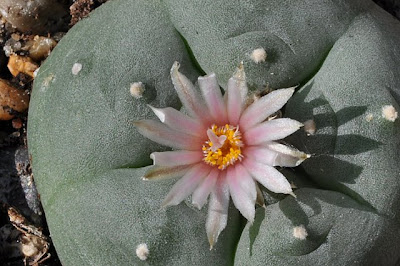
Flowering Lophophora williamsii (El Huizache, San Luis Potosí)
The first plant I want to show off is a flowering Lophophora williamsii grown from seed originating from the El Huizache, San Luis Potosí, Mexico population (the population Anderson assigned as the neotype for the species). These plants are from a more southerly location than the ones I'm usually growing and I'm happy to see they are coping so well with the cold conditions during winter. I was getting used to thinking of all L. williamsii varieties as self-fertile but according to the Cactus Conservation Institute, greenhouse breeding experiments by Bohata and colleagues in the Czech Republic and by Köhres in Germany have shown that plants from the El Huizache population are self-sterile and therefore obligate outcrossers (leading one to suspect a great deal of genetic diversity within plants from this population – in contrast to the self-fertile populations that have little to no genetic diversity among individuals as they outcross very little). 
Lophophora williamsii (El Huizache) flower with long style
The flowers of the El Huizache plants also seem to have a very long style that raises the stigma well above the stamens, making it hard, if not impossible, for the plants to reproduce without the help of a pollinator.
Bumble bee having fun with a Lophophora williamsii flower
Speaking of pollinators a bumble bee visited while I took these pictures – unfortunately only this one Lophophora flowered at the time making it impossible for the bee to fertilize the plant. The bumble bees that are active in early spring are huge; I don't know much about bees but am told that these large slow individuals are queen bees looking for nectar and pollen to feed their newly hatched brood.
Lophophora williamsii (SB 854; Starr Co, Texas) with fresh fruit
One of the Lophophora williamsii (SB 854; Starr Co, Texas) plants that I recently repotted has spawned a fruit. This variety of Lophophora williamsii is self-fertile to an extent where it happily sets seed if you just shake the flower a bit.
Flowering Acharagma roseana (LX 578; Ramon Arizpe, Coahuila)
My Acharagma roseana plants (LX 578; Ramon Arizpe, Coahuila - “Ramon” should probably read “Ramos” but I'll stick to the information from the vendors seed list) are coming of age. The plants were started from seed 4 years ago and are all ready to flower, displaying a wealth of flower buds. Only one, shown in the picture above, flowered when I took the pictures. Unfortunately it will be a while before I can visit my summerhouse (and coldhouse) again – I hope at least a few of the flowers will be saved for then. My Echinocereus reichenbachii plants are also growing a multitude of buds, getting ready for a flower fest I would hate to miss.
Frost damaged Matucana madisoniorum
Until now I have focused entirely on the success stories but a few of my plants didn't like being without heat during winter. My Matucana madisoniorum definitely didn't like the cold conditions (even being wrapped in multiple layers of horticultural fleece). The plant is heavily marked by the experience but survives.
I also lost a few plants: a couple of Carnegia gigantea (saguaro cactus), a Cylindropuntia bigelovii (teddy-bear cholla), and a Cylindropuntia tunicata (thistle cholla); I managed to save cuttings of the chollas though. These plants were kept out on the terrace all summer and I probably left them out for too long, exposing them to the autumn storms so the plants were not able to dry out completely before winter. I'm especially sad about the Carnegia gigantea plants as they were great specimens and are now completely reduced to mush.
All Time Most Popular Posts
-
Lophophora williamsii (peyote) populations have diminished in large areas of South Texas where peyoteros harvest the cactus for ceremonial ...
-
On various occasions I've been asked what growing media I'm using for my cactus plants. I don't have a set soil mix recipe as su...
-
Below is a list of retailers/nurseries selling cactus seed and plants. I've only listed vendors I've done business with. If you ar...
-
Most cacti are easily grown from seed - and with a little patience and care they can be grown into beautiful plants. Lophophora williamsi...
-
In last month’s post on the troubled Texan peyoteros I referred to Anderson’s article on the peyote situation in Texas. Given the importanc...
-
Yet another slightly off topic and probably not entirely politically correct post, but I couldn’t help noticing the similarity of my monstr...
-
Flowering stand of San Pedro cacti (Trichocereus pachanoi) To me the main draw of the San Pedro cactus ( Trichocereus pachanoi (syn. Ech...
-
In the June 2008 issue of the Cactus & Co magazine Jaroslav Šnicer, Jaroslav Bohata, and Vojtěch Myšák described a new Lophophora spec...
-
There seems to be an increased focus on the alarming Texas peyote situation. A couple of weeks ago the Houston Press published a mournful, i...
-
I spent two weeks working in Delhi, India during January. I had one weekend off and had planned to spend it in Delhi at my own leisure, but ...





















